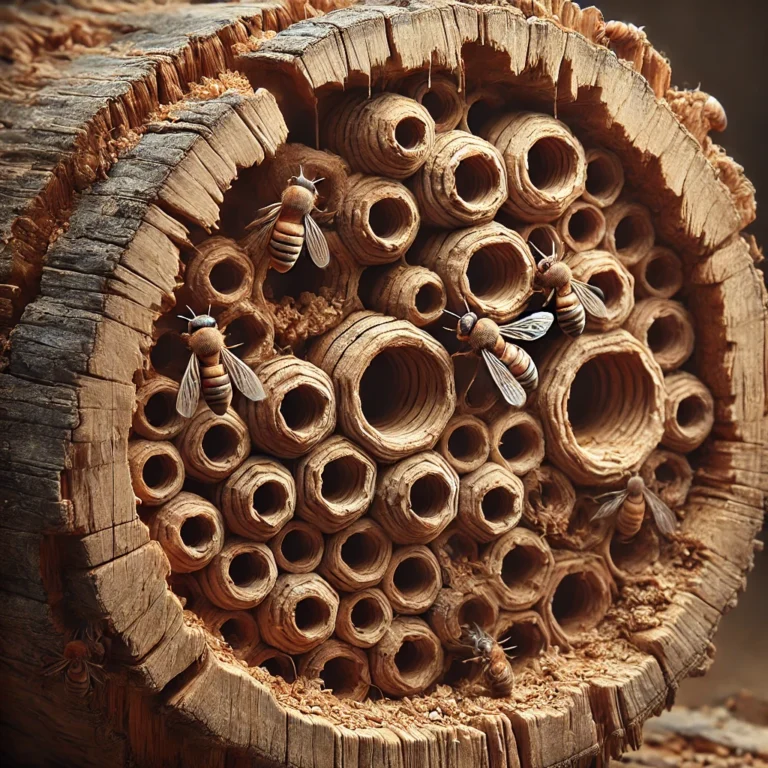Carpenter bees are fascinating yet troublesome creatures that often catch the attention of homeowners, especially those with wooden structures. If you’ve ever noticed perfectly round holes drilled into wood around your property, you’ve likely encountered carpenter bees. But what lies beyond those small openings? What’s actually inside a carpenter bee nest? In this article, we’ll take you on a journey into the hidden world of carpenter bees, revealing what’s inside their nests, why they choose to nest in wood, and what you should know to protect your home.
The Structure of a Carpenter Bee Nest
- The Entrance Hole
- Precision Drilling: Carpenter bees are notorious for their ability to drill nearly perfect circular holes in wood. These entry holes typically measure about half an inch in diameter and serve as the gateway to the nest.
- Strategic Placement: Bees choose locations that offer protection from the elements and predators. The entry hole is usually drilled in a spot that is somewhat sheltered, like the underside of wooden eaves, decks, or railings.
- The Main Tunnel
- Length and Depth: After entering through the small, round hole, a carpenter bee begins to burrow into the wood, creating a tunnel that can extend up to six inches or more. In some cases, the tunnel may branch off into different directions, creating a more complex network within the wood.
- Wood Shavings: As the bee digs into the wood, it creates wood shavings, which are often visible around the entrance hole. These shavings are a telltale sign that a carpenter bee is hard at work inside.
- Brood Chambers
- Creating Space: Once the main tunnel is established, the carpenter bee starts to carve out brood chambers, which are small, individual cells within the tunnel where eggs will be laid.
- Food Supply: The female carpenter bee provides each brood chamber with a supply of pollen and nectar. This food mixture, known as bee bread, is essential for the developing larvae and ensures they have the nutrients they need to grow.
The Life Inside a Carpenter Bee Nest
- Eggs and Larvae
- Egg Laying: Inside each brood chamber, the female carpenter bee lays a single egg. She carefully seals the chamber with a wall made of chewed wood pulp, ensuring the egg is protected and has access to the stored food.
- Larval Stage: Once the egg hatches, the larva begins feeding on the bee bread. Over the course of a few weeks, the larva goes through several stages of development, eventually pupating and transforming into an adult bee.
- Pupation and Emergence
- Pupa to Adult: The transformation from larva to adult occurs within the sealed brood chamber. During this time, the bee is vulnerable, but the protective enclosure ensures its safety.
- Emerging from the Nest: After pupation is complete, the new adult bee chews its way out of the brood chamber and emerges from the nest. This usually happens in late summer or early fall, depending on the climate and the specific species of carpenter bee.
Why Carpenter Bees Choose Wood ?
- Natural Instincts
- Wood Preference: Carpenter bees are naturally drawn to wood as it provides the ideal conditions for nesting. The wood’s texture allows them to easily excavate tunnels, and the enclosed environment offers protection from predators.
- Preferred Types of Wood: These bees prefer untreated, weathered wood, which is easier to burrow into. However, they can also target painted or treated wood if it’s starting to show signs of wear and tear.
- Impact on Wooden Structures
- Potential Damage: While a single nest may not cause significant damage, multiple nests over several seasons can weaken wooden structures. This is why it’s crucial to monitor for signs of carpenter bee activity and take preventive measures when necessary.
How to Identify a Carpenter Bee Nest ?
- Visible Signs
- Entrance Holes: Look for the characteristic round holes in wooden structures around your home. These are the most obvious signs of a carpenter bee nest.
- Wood Shavings: The presence of wood shavings, or “frass,” around the entrance hole is another clear indicator of nesting activity.
- Auditory Clues
- Buzzing Sounds: You might hear a buzzing sound coming from within the wood, especially during the active nesting period in the spring and early summer. This sound is a sign that carpenter bees are inside, excavating their tunnels.
Final Thoughts
The inside of a carpenter bee nest is a hidden world of meticulous construction and careful planning. From the entrance hole to the brood chambers, these nests are designed to protect and nurture the next generation of carpenter bees. While they play an essential role in pollination, their nesting habits can be damaging to wooden structures. Understanding what’s inside a carpenter bee nest can help you take the necessary steps to protect your home while appreciating the complexity of these industrious insects.
Resources
- Carpenter Bee Control: University of Kentucky Entomology
- Bee Conservation: Xerces Society
- Home Maintenance Tips: This Old House
FAQs
- How deep do carpenter bees burrow?
- Carpenter bees typically burrow 6-8 inches into the wood, but some tunnels can be longer.
- Can a single carpenter bee nest cause significant damage?
- While one nest might not cause severe damage, multiple nests over time can weaken wooden structures.
- How can I prevent carpenter bees from nesting in my home?
- Painting or sealing wood surfaces and using carpenter bee traps are effective prevention methods.
- What should I do if I find a carpenter bee nest?
- You can remove the bees using insecticides or traps and seal the holes to prevent re-infestation.
- Are carpenter bees aggressive?
- Male carpenter bees may act aggressively, but they cannot sting. Females can sting but are typically non-aggressive.



